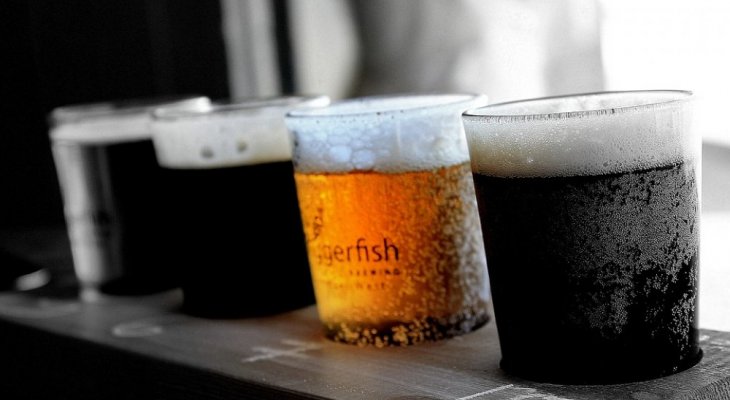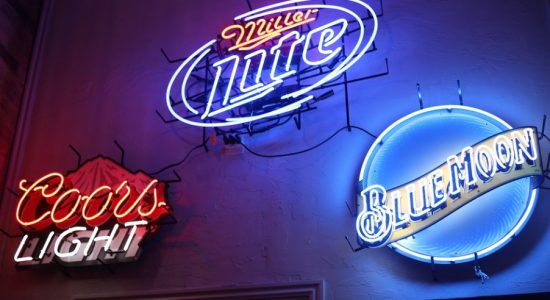How Many Types Of Lager Are There? (The Complete List!)

If you’re one of those people that love beer, and I mean to the degree of shaking your head at any other drink offered. Then, you’ve come to the right place to get your questions answered about the many types of lagers.
How Many Types of Lagers are There? There are many types of lagers including: Pale lagers, dark lagers, Dortmunder, Eisbock, Vienna lager, Munich Dunkel, Munich Helles, etc.? Each offers distinct palatableness all while staying true to their lager origin.
I promise you’ll want to go out and taste them all after this.
With the most recent popularity of craft beers and images of hearty mustaches kissed with that celestial foam, who knows, maybe you’ll end up making your own! With beers, especially lagers, the sky’s the limit.
Read Also: What Is The Easiest Type Of Beer To Brew?
A Little Beer History!
Going straight into the types of lagers without learning a bit about the wonderful history of beer is a crime. So, grab yourself your favorite lager and enjoy this article as you would enjoy it – slowly quenching your thirst.
Beer has a history and an interesting one at that. Historical findings suggest that the first beer was brewed as many as 8,000 years ago. But, who invented this sweet elixir? Well, Sumerian Civilization, actually. If you haven’t heard from them, their race is actually remembered by giving birth to modern institutions such as democracy and society, even before the Romans and Greeks ever spoke on the subject.
The Sumerians brewed such a nutrient-filled beer that it was consumed more than water! They even composed songs and wrote poems to Ninkasi, their “goddess of beer”, using their recipes as inspiration.
This might sound like a drunk inside-joke result of a night out, but actually, the Sumerians knew what they were doing.
However, even predating the Sumerians, archaeologists have found beer originates from bread. When damp grains were fermented in airborne yeasts, this caused the spontaneous fermentation and created an inebriating pulp… and the rest is history.
NOTE: the word “beer” actually comes from the Latin word that means “to drink.”
What are Lagers?
No beer conversation would ever be complete without talking about the famous lagers. To most beer enthusiasts, lager tastes more “crispy”, in a sense, in comparison to ales.
However, to brewers, what separates the two are the different kinds of yeast used during the fermentation process.
This not only affects the taste, but it also affects color, flavor, aroma, hops, grains, and malts. Even the water hardness.
How are Lagers Made?
Essential for lagers, once the beer is fermented, is its storing or “lagering” in cold places like cellars, caves etc. for weeks/months at a time at temperatures of 40° F. This is a process called “cold fermentation”, this gives lagers their distinctive clean taste.
Fun fact: Brewers know when lager is being made because it smells like rotten eggs during the fermentation process.
This “lagering” process actually makes your beer look cleaner and clearer. Lagering is every bit as important as aging wine or mead.
The cold temperatures the lagering process has, drop the remaining yeast sediments, which in the end, creates a brilliant looking beer.
If you’re into home brewing, imagine serving a batch of Dortmunder or Pils in this clear, almost magical solution. What’s the secret? – They’ll ask. Well, lagering it!
How Many Types of Lager are there?
Ah, the million-dollar question. Well, when it comes to the different types of lagers you have to understand, right off the bat, that there are five main lager categories:
- Pale lagers
- Amber lagers
- Dark lagers
- Bock
- Specialty lagers
These hold their own unique varieties. For instance, American pale lagers will have their differences depending on the brand, but they do tend to hold the same alcoholic percentages (4%-5%).
The same goes for taste, with an “adjunct” flavor and smell. Adjunct refers to unmalted grains. American Pale lagers quench thirst quickly because of this distinctive flavoring and are designed to be served very cold!
The Different Types of Lagers
American Pale Lagers
- Description: Like mentioned before, quality and overall taste will differ from brand to brand, especially in the mind of consumers that are not as beer-savvy. This is thanks to every brand’s advertising campaigns.
- Appearance: Light in color, watery, light, and gassy.
- Taste/aroma: Designed to be served very gold, they are the supreme thirst quenchers of lagers. Adjunct flavor and aroma. They have a delicate sweetness to them.
American Dark Lagers
- Description: A dark pale lager, with a small amount of residual sweetness from the caramel malts and light roasted notes coming from the coloring malt.
- Appearance: Deep amber to dark brown/ruby.
- Taste/aroma: Little to no malt aroma. Caramel or roasted notes. There’s a slight sweetness to it. It may taste like caramel, coffee or cocoa roasted flavors when roasted malts are used.
Bock Beer
- Description: A strong dark beer, robust history and flavoring which dates back to the Medieval era.
- Appearance: Dark amber in color.
- Taste/Aroma: A very light hoppiness, strong, robust malt flavors. A smooth mouthfeel and low carbonation. When more hops are added it tastes maltier, heavier, and is darker
Doppelbock
- Description: Rich body and high in alcohol. It was first brewed in the Italian Alps by monks of the St.Francis of Paula monastery.
- Appearance: Dark ruby to brown color and creamy head.
- Taste/aroma: Features a toasty quality and a strong malt presence, the body is rich and full, dark chocolate notes can be found in the background. Most are smooth overall.
Dortmunder Export
- Description: It offers the maltiness of a Munich Hells and on the other hand, the hoppiness of a Pilsner. This lager is all about balance and character.
- Appearance: Features light to deep golden with a persistent white head.
- Taste/aroma: Stronger than both Munich Hells and Pilsner. The aroma is grainy but somewhat sweet. It is a crisp but quite refreshing beer.
Eisbock
- Description: Eisbock or “ice bock” is an anomaly in the brewing world. It’s essentially a Doppelbock lager that has been frozen to concentrate its flavor and alcohol. It’s strong, full in body, and super-rich.
- Appearance: Ranges from copper to dark brown, although its lagering can make it lighter and provides more clarity.
- Taste/aroma: Malty and toasty and a definitive alcohol presence. In taste, it is sweet in malt flavors with some caramel and toasty qualities.
Helles Bock
- Description?: A paler “Helles” (pale in German) version of Bock Beer. A distinctive overall crisp and clean lager.
- Appearance: A stunning golden color.
- Taste/aroma: Exerts a malt-forward characteristic. It is medium-bodied, and is a bit beadier in taste and pours heavy.
Maibock
- Description: It’s brewed in “mai” (May in German). In comparison to Helles Bock, it’s much lighter and drier in the finish.
- Appearance: Ranges from deep gold to bright amber.
- Taste/aroma: It has much balance, there are notes of toasty malts, and spicy almost peppery notes from the hops.
Marzenbeir/Oktoberfest Beers
- Description: Stored in caves over the summer and traditionally brewed in “Marz” (March in German) and served in autumn during harvest celebrations.
- Appearance: It features a lovely amber color.
- Taste/aroma: Very malt-forward and light and easy to drink.
Munich Dunkel
- Description: A darker and maltier beer compared to other lagers brewed in the region of Munich. It is also darker and maltier than the Munich Hells – its counterpart.
- Appearance: Ranges from a deep copper to almost brownish red and pretty clear.
- Taste/aroma: Medium to medium-full bodied. Malty aroma combined with toasted bread, there might be spice hints with toffee, chocolate, and herbs as well.
Munich Helles
- Description: This is a pale lager. Clean on the palate. Arising as a way of competing with Czech Pilsners.
- Appearance: Bright golden in color.
- Taste/aroma: Sweet aroma with hints of spicy hops. In taste, it is sweetly accompanied by malt-forward hints, with toasted, bready elements. Clean and moderately carbonated.
Pilsner
- Description: Pilsner lager beers originate in the Czech Republic they incorporate a few floral aromas. They’re what many popular American brand-name beers aspire to be.
- Appearance: Medium to medium-full bodied, it has pretty high carbonation. It is an amber/golden color, but German Pilsner beers are much lighter in color and body.
- Taste/aroma: A crisp, bitter finish, with varieties of hops that also have floral aromas. A round mouthfeel due to the alcoholic percentage which is typically around 5%.
Schwarbier
- Description: This lager type originates in northern Bavaria, it’s darker and drier than the Munich Dunkel and less sweet on the palate.
- Appearance: Dark brown but not quite black, moderate to moderate-high carbonation.
- Taste/aroma: It holds a moderate malt taste which can be neutral or almost bready, it’s smooth on the palate, and has a medium to medium-light body. It can also be floral, spicy, or herbal in its variations.
Vienna lager
- Description: Originating in the country of Austria, cousin of the Maszenbier, it was widely visible in Mexico, more than its country of origin due to the ruling of Emperor Maximilian in the 1800s.
- Appearance: Ranges from copper to reddish-brown color, it is brilliant to clear and has medium rising colors.
- Taste/aroma: Bitterness ranges from very low to low. It’s mild alcohol content and an aroma of slightly roasted malt. The malt is slightly sweet.
Final thoughts
If you were wondering about the wide array of lagers in the beer world, now you know much more about them.
Hopefully, you get to try them all, show off to your friends and pinpoint your favorites to have them over meals, get-togethers, barbecues, or just when in the mood.
After all, beer is perfect for any occasion. Especially… a refreshing lager. Excuse me while I go grab one right now.
Read Also: Best Beer Recipe Kits






